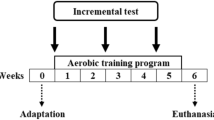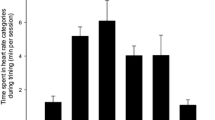Abstract
The purpose of this study was to investigate whether creatine (Cr) supplementation during 12 weeks of phasic high-frequency voluntary wheel running would result in a faster myosin heavy chain (MHC) isoform profile in the rat mixed fast-twitch plantaris and alter its corresponding isometric contractile properties. The fast-twitch extensor digitorum longus and medial gastrocnemius and slow-twitch soleus were also studied. Forty weanling Sprague–Dawley male rats were assigned to one of four groups: creatine-sedentary (Cre-Sed); creatine-voluntary running (Cre-Run); control-sedentary (Con-Sed); control-voluntary running (Con-Run). Daily running distance was similar between Cre-Run and Con-Run. Average daily Cr ingestion was also similar being 2.4±0.17 and 3.0±0.14 g/kg in Cre-Sed and Cre-Run, respectively. Total creatine (TCr) content was elevated (P<0.03) in the plantaris of Cre-Run [211.4±16.9 mmol/kg dry weight (dw)], compared with Con-Run (175.1±5.69). In the plantaris, MHCIIb was 13% greater (P<0.00001) in Cre-Run compared with Con-Run, while MHCIId/x and MHCIIa were lower in Cre-Run by 7 and 6% (P<0.0002), respectively. No differences were observed in twitch force, time-to-peak tension, half-rise time or half-fall time. Greater tetanic force production (P<0.05) in Cre-Sed compared with Con-Sed corresponded to a 12% increase in MHCIId/x (P<0.0001) and a 12% decrease in MHCIIb (P<0.0006). The fatigue index of the plantaris at 10 s (FI10s) was reduced only after running (Cre-Run vs Con-Run), while in all other muscles the FI10s was lower only in the Cre-Sed group. In conclusion, Cr supplementation had differential effects on MHC isoform content and fatigability that depended on the level of contractile activity. Cr feeding combined with running exercise resulted in a faster MHC-based phenotype in the rat plantaris but the impact on associated isometric contractile properties was minimal.





Similar content being viewed by others
References
Pette D (2002) The adaptive potential of skeletal muscle fibers. Can J Appl Physiol 27:423–448
Ren JM, Ohira Y, Holloszy JO, Hämäläinen N, Traub I, Pette D (1995) Effects of beta-guanidinopropionic acid-feeding on the patterns of myosin isoforms in rat fast-twitch muscle. Pflügers Arch 430:389–393
Green HJ, Düsterhöft S, Dux L, Pette D (1992) Metabolite patterns related to exhaustion, recovery and transformation of chronically stimulated rabbit fast-twitch muscle. Pflügers Arch 420:359–366
Conjard A, Peuker H, Pette D (1998) Energy state and myosin heavy chain isoforms in single fibres of normal and transforming rabbit muscles. Pflügers Arch 436:962–969
Freyssenet D, Berthon P, Barthelemy JC, Busso T, Geyssant A, Denis C (1995) Energetic status and mitochondrial oxidative capacity of rat skeletal muscle in response to creatine analogue ingestion. Biochim Biophys Acta 1228:211–215
Petrofsky JS, Fitch CD (1980) Contractile characteristics of skeletal muscles depleted of phosphocreatine. Pflügers Arch 384:123–129
Roy BD, Bourgeois JM, Mahoney DJ, Tarnopolsky MA (2002) Dietary supplementation with creatine monohydrate prevents corticosteroid-induced attenuation of growth in young rats. Can J Physiol Pharmacol 80:1008–1014
Brannon TA, Adams GR, Conniff CL, Baldwin KM (1997) Effects of creatine loading and training on running performance and biochemical properties of rat skeletal muscle. Med Sci Sports Exerc 29:489–495
Eijnde BO, Lebacq J, Ramaekers M, Hespel P (2004) Effect of muscle creatine content manipulation on contractile properties in mouse muscles. Muscle Nerve 29:428–435
Harris RC, Soderlund K, Hultman E (1992) Elevation of creatine in resting and exercised muscle of normal subjects by creatine supplementation. Clin Sci 83:367–374
Hultman E, Soderlund K, Timmons JA, Cederblad G, Greenhaff PL (1996) Muscle creatine loading in men. J Appl Physiol 81:232–237
Ingwall JS (1976) Creatine and the control of muscle-specific protein synthesis in cardiac and skeletal muscle. Circ Res 38:I-115–I-123
Ingwall JS, Weiner CD, Morales MF, Davis E, Stockdale FE (1974) Specificity of creatine in the control of muscle protein synthesis. J Cell Biol 62:145–151
Wallimann T, Dolder M, Schlattner U, Eder M, Hornemann T, O’Gorman E, Ruck A, Brdiczka D (1998) Some new aspects of creatine kinase (CK): compartmentation, structure, function and regulation for cellular and mitochondrial bioenergetics and physiology. BioFactors 8:229–234
Kariya F, Yamauchi H, Kobayashi K, Narusawa M, Nakahara Y (2004) Effects of prolonged voluntary wheel-running on muscle structure and function in rat skeletal muscle. Eur J Appl Physiol 92:90–97
Morse AD, Russell JC, Hunt TW, Wood GO, Epling WF, Pierce WD (1995) Diurnal variation of intensive running in food-deprived rats. Can J Physiol Pharmacol 73:1519–1523
Gallo M, Gordon T, Tyreman N, Shu Y, Putman CT (2004) Reliability of isolated isometric function measures in rat muscles composed of different fibre types. Exp Physiol 89:583–592
Gordon T, Tyreman N, Rafuse VF, Munson JB (1997) Fast-to-slow conversion following chronic low-frequency activation of medial gastrocnemius muscle in cats. I. Muscle and motor unit properties. J Neurophysiol 77:2585–2604
McCartney N, Heigenhauser GJF, Jones NL (1983) Power output and fatigue of human muscle in maximal cycling exercise. J Appl Physiol 55(1):218–224
Ally A, Park G (1992) Rapid determination of creatine, phosphocreatine, purine bases and nucleotides (ATP, ADP, AMP, GTP, GDP) in heart biopsies by gradient ion-pair reversed-phase liquid chromatography. J Chromatogr 575:19–27
Lawson JWR, Veech RL (1979) Effects of pH and Free Mg2+ on the Keq of the creatine kinase reaction and other phosphate hydrolyses and phosphate transfer reactions. J Biol Chem 254(14):6528–6537
Golding EM, Teague WE Jr, Dobson GP (1995) Adjustment of K′ to varying pH and pMg for the creatine kinase, adenylate kinase and ATP hydrolysis equilibria permitting quantitative bioenergetic assessment. J Exp Biol 198:1775–1782
Adams GR, Baldwin KM (1995) Age dependence of myosin heavy chain transitions induced by creatine depletion in rat skeletal muscle. J Appl Physiol 78:368–371
Putman CT, Dixon WT, Pearcey J, MacLean IM, Jendral MJ, Kiricsi M, Murdoch GK, Pette D (2004) Chronic low-frequency stimulation up-regulates uncoupling protein-3 in transforming rat fast-twitch skeletal muscle. Am J Physiol Regul Integr Comp Physiol 287:R1419–R1426
Close R (1969) Dynamic properties of fast and slow skeletal muscles of the rat after nerve cross-union. J Physiol 204:331–346
Trump ME, Heigenhauser GJ, Putman CT, Spriet LL (1996) Importance of muscle phosphocreatine during intermittent maximal cycling. J Appl Physiol 80:1574–1580
Spriet LL, Matsos CG, Peters SJ, Heigenhauser GJ, Jones NL (1985) Muscle metabolism and performance in perfused rat hindquarter during heavy exercise. Am J Physiol 248:C109–C118
Greenhaff PL, Bodin K, Soderlund K, Hultman E (1994) Effect of oral creatine supplementation on skeletal muscle phosphocreatine resynthesis. Am J Physiol 266:E725–E730
Moraska A, Deak T, Spencer RL, Roth D, Fleshner M (2000) Treadmill running produces both positive and negative physiological adaptations in Sprague–Dawley rats. Am J Physiol Regul Integr Comp Physiol 279:R1321–R1329
Rodnick KJ, Reaven GM, Haskell WL, Sims CR, Mondon CE (1989) Variations in running activity and enzymatic adaptations in voluntary running rats. J Appl Physiol 66:1250–1257
Shepherd RE, Gollnick PD (1976) Oxygen uptake of rats at different work intensities. Pflgers Arch 362:219–222
Syrotuik DG, Bell GJ (2004) Acute creatine monohydrate supplementation: a descriptive physiological profile of responders vs. nonresponders. J Strength Cond Res 18:610–617
Steenge GR, Lambourne J, Casey A, Macdonald IA, Greenhaff PL (1998) Stimulatory effect of insulin on creatine accumulation in human skeletal muscle. Am J Physiol 275:E974–E979
Robinson TM, Sewell DA, Hultman E, Greenhaff PL (1999) Role of submaximal exercise in promoting creatine and glycogen accumulation in human skeletal muscle. J Appl Physiol 87:598–604
McMillen J, Donovan CM, Messer JI, Willis WT (2001) Energetic driving forces are maintained in resting rat skeletal muscle after dietary creatine supplementation. J Appl Physiol 90:62–66
Loike JD, Zalutsky DL, Kaback E, Miranda AF, Silverstein SC (1988) Extracellular creatine regulates creatine transport in rat and human muscle cells. Proc Natl Acad Sci USA 85:807–811
Guerrero-Ontiveros ML, Wallimann T (1998) Creatine supplementation in health and disease. Effects of chronic creatine ingestion in vivo: down-regulation of the expression of creatine transporter isoforms in skeletal muscle. Mol Cell Biochem 184:427–437
Pette D, Staron RS (1997) Mammalian skeletal muscle fiber type transitions. Int Rev Cytol 170:143–223
Pette D, Staron RS (2000) Myosin isoforms, muscle fiber types, and transitions. Microsc Res Tech 50:500–509
Pette D (1998) Training effects on the contractile apparatus. Acta Physiol Scand 162:367–376
Bottinelli R, Schiaffino S, Reggiani C (1991) Force–velocity relations and myosin heavy chain isoform compositions of skinned fibres from rat skeletal muscle. J Physiol 437:655–672
Bottinelli R, Betto R, Schiaffino S, Reggiani C (1994) Unloaded shortening velocity and myosin heavy chain and alkali light chain isoform composition in rat skeletal muscle fibres. J Physiol 478 (Pt 2):341–349
Bessman SP (1987) The creatine phosphate energy shuttle—the molecular asymmetry of a “pool”. Anal Biochem 161:519–523
Pulido SM, Passaquin AC, Leijendekker WJ, Challet C, Wallimann T, Ruegg UT (1998) Creatine supplementation improves intracellular Ca2+ handling and survival in mdx skeletal muscle cells. FEBS Lett 439:357–362
Steeghs K, Benders A, Oerlemans F, de Haan A, Heerschap A, Ruitenbeek W, Jost C, van Deursen J, Perryman B, Pette D, Bruckwilder M, Koudijs J, Jap P, Veerkamp J, Wieringa B (1997) Altered Ca2+ responses in muscles with combined mitochondrial and cytosolic creatine kinase deficiencies. Cell 89:93–103
Chin ER, Grange RW, Viau F, Simard AR, Humphries C, Shelton J, Bassel-Duby R, Williams RS, Michel RN (2003) Alterations in slow-twitch muscle phenotype in transgenic mice overexpressing the Ca2+ buffering protein parvalbumin. J Physiol 547(Pt 2):649–663
Schwaller B, Dick J, Dhoot G, Carroll S, Vrbová G, Nicotera P, Pette D, Wyss A, Bluethmann H, Hunziker W, Celio MR (1999) Prolonged contraction–relaxation cycle of fast-twitch muscles in parvalbumin knockout mice. Am J Physiol Cell Physiol 276:C395–C403
Carroll S, Nicotera P, Pette D (1999) Calcium transients in single fibers of low-frequency stimulated fast-twitch muscle of rat. Am J Physiol Cell Physiol 277:C1122–C1129
Naya FJ, Mercer B, Shelton J, Richardson JA, Williams RS, Olson EN (2000) Stimulation of slow skeletal muscle fiber gene expression by calcineurin in vivo. J Biol Chem 275:4545–4548
Acknowledgements
This study was funded by research grants from the Natural Sciences and Engineering Council of Canada (NSERC) (to CT Putman), the Alberta Heritage Foundation for Medical Research (AHFMR) (to CT Putman) and the Canadian Institutes of Health Research (to T Gordon). M Gallo was supported by a NSERC Postgraduate Scholarship and an Izaak Walton Killam Memorial Scholarship and an Andrew Stewart Memorial Graduate Prize from the University of Alberta. CT Putman is a Heritage Medical Scholar of AHFMR. T Gordon is a Heritage Senior Scientist of AHFMR.
Author information
Authors and Affiliations
Corresponding author
Rights and permissions
About this article
Cite this article
Gallo, M., Gordon, T., Syrotuik, D. et al. Effects of long-term creatine feeding and running on isometric functional measures and myosin heavy chain content of rat skeletal muscles. Pflugers Arch - Eur J Physiol 452, 744–755 (2006). https://doi.org/10.1007/s00424-006-0079-0
Received:
Revised:
Accepted:
Published:
Issue Date:
DOI: https://doi.org/10.1007/s00424-006-0079-0




